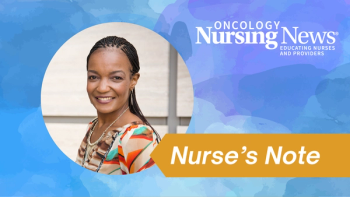
- January/February 2015
- Volume 9
- Issue 1
"The Sixth Vital Sign": Screening for Psychosocial Distress
Screening for psychosocial distress is an important component of care, and has even been referred to as the "sixth vital sign."
Lisa Schulmeister, RN, MN, APRN-BC, OCN®, FAAN
Editor-in-Chief OncLive Nursing
Oncology Nursing Consultant, Adjunct Assistant Professor of Nursing Louisiana State Health Sciences Center in New Orleans, Louisiana
Screening for psychosocial distress is an important component of care, and has even been referred to as the “sixth vital sign.” The goal of distress screening is to facilitate timely and appropriate access to psychosocial services and improve the patient’s quality of life. In reality, though, psychosocial distress screening is not as simple as it appears.
The first issue is that distress screening is everyone’s job, which often ends up meaning that it’s nobody’s job. In practice settings in which “we all” need to screen for distress, chart documentation often reveals that distress is documented using standardized language (eg, patients have “no anxiety, no depression”), is inconsistently documented on some but not all dates, or noted differently by one or more clinicians.
There also is confusion about what we’re doing, or supposed to do. Depending on the practice setting, we generally are screening for psychosocial distress and not assessing for it. Screening is the rapid identification of a patient’s key concerns, whereas assessment is conducted after the screening and involves a more comprehensive and focused exploration of the patient and family’s situation.
Screening Extends Beyond the Patient
The scope of psychosocial distress screening extends beyond the patient to encompass family members and clinicians; however, in practice, the patient is often the only one who is screened for distress. The stress of caregiving can have a negative impact on the well-being of the family caregiver, which in turn, can negatively impact the caregiver's ability to provide care and support. When the caregiver/patient dyad is recognized as the unit of care, actions can be taken to promote the well-being of both the patient and caregiver.
No one will argue that all patients should be screened for distress. The conundrum is when to screen, how to screen, and what to screen. In terms of frequency, it’s common for distress screening to occur at the time of cancer diagnosis and continue at specified intervals (eg, monthly, bimonthly), at subsequent critical time points (eg, end of treatment, when disease progression occurs), or as needed when distress is either self-identified by the patient or recognized by the clinician.
Perhaps the easiest process is to screen for distress at every clinical or treatment visit, which is the frequency stated in the ASCO/ONS Chemotherapy Administration Safety Standards. When screening is conducted every time instead of some of the time, it’s less likely that it will be overlooked.
You’re probably thinking you don’t have the staff, time, expertise, and tools to screen for distress every time a patient comes in. And you may be right, because distress screening does take time, depending on how you do it. The widely used NCCN Distress Thermometer for Patients (available at NCCN.org) includes yes/no checkboxes for noting practical problems (eg, housing, work/school, transportation, etc.), spiritual concerns, and family, emotional, and physical problems. It’s a comprehensive tool, and when fully completed by patients, provides a great deal of information.
One problem with the tool, however, is that it has 41 items and does not prioritize concerns. Consequently, some patients find the tool burdensome to complete (especially if they are being seen frequently), and clinicians often don’t know where to start when patients check several items on the list. In some facilities, the NCCN tool is electronic, with patients or clinicians entering the patient’s responses. However, many facilities still rely on paper/pencil completion of the tool, and the tool is either scanned into the electronic medical record or the responses are manually entered. To reduce the paper burden, the tool can be laminated, which allows the patient to check the boxes using a wipe-away marker and enables the tool to be cleaned, sanitized, and used with subsequent patients.
Simplifying the Process
To reduce the time burden to both patient and clinician, an abbreviated distress screening process is an option. Ask the patient to rate either distress or emotional well-being on a 0-10 scale, and ask if the patient has housing, transportation, work/school, family, spiritual, or physical concerns. Measuring distress using a thermometer or other rating scale makes it possible to assess distress over time, and having specified distress scores that trigger action standardizes the intervention and referral process.
While some tools, such as the Edmonton Symptom Assessment System, have a rating scale, which assists in identifying problems that are more concerning to the patient than others, several tools (including the NCCN Distress Thermometer) contain yes/no checkboxes. When multiple items are checked, follow-up is required to explore each one to determine how to prioritize the patient’s needs.
Regardless of the distress screening tool used, a helpful question to ask is, “What is of most concern to you right now?” Not only does this question help prioritize care, it’s also broader and may elicit concerns that are not stated on any tool. For instance, a woman recently responded to the question by saying that she was very worried about how her son was doing in school. It’s possible, but unlikely, that a tool would have identified her concern.
Psychosocial distress has many dimensions, and simply asking if the patient is anxious or depressed is not enough. By standardizing the screening process, involving the patient’s caregiver, and addressing the multidimensional aspects of distress, optimal psychosocial care can be provided.
Articles in this issue
almost 11 years ago
Big Changes Anticipated in Treatment Paradigmsalmost 11 years ago
Research Strides Change Treatment Landscape for Blood Cancersalmost 11 years ago
Recognizing Distress in Patients with Acute Leukemiaalmost 11 years ago
Improving Safety and Quality with Oral Chemotherapyalmost 11 years ago
Reaching Out, Getting Answers, to Understand Treatment OptionsNewsletter
Knowledge is power. Don’t miss the most recent breakthroughs in cancer care.














































































